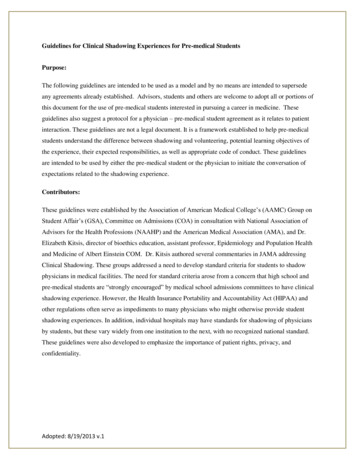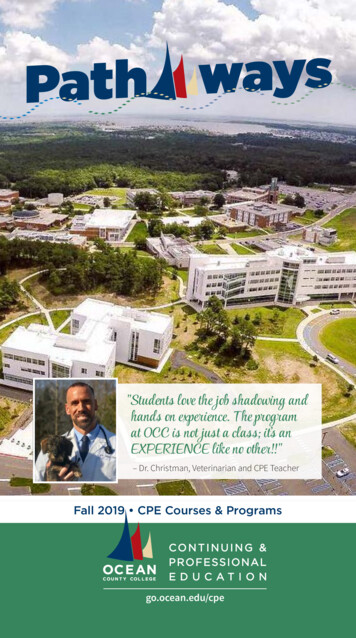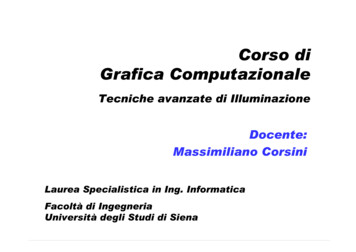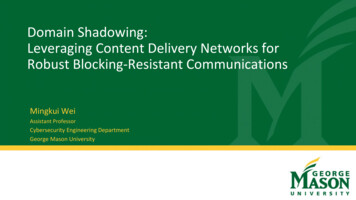
Transcription
Guidelines for Clinical Shadowing Experiences for Pre-medical StudentsPurpose:The following guidelines are intended to be used as a model and by no means are intended to supersedeany agreements already established. Advisors, students and others are welcome to adopt all or portions ofthis document for the use of pre-medical students interested in pursuing a career in medicine. Theseguidelines also suggest a protocol for a physician – pre-medical student agreement as it relates to patientinteraction. These guidelines are not a legal document. It is a framework established to help pre-medicalstudents understand the difference between shadowing and volunteering, potential learning objectives ofthe experience, their expected responsibilities, as well as appropriate code of conduct. These guidelinesare intended to be used by either the pre-medical student or the physician to initiate the conversation ofexpectations related to the shadowing experience.Contributors:These guidelines were established by the Association of American Medical College’s (AAMC) Group onStudent Affair’s (GSA), Committee on Admissions (COA) in consultation with National Association ofAdvisors for the Health Professions (NAAHP) and the American Medical Association (AMA), and Dr.Elizabeth Kitsis, director of bioethics education, assistant professor, Epidemiology and Population Healthand Medicine of Albert Einstein COM. Dr. Kitsis authored several commentaries in JAMA addressingClinical Shadowing. These groups addressed a need to develop standard criteria for students to shadowphysicians in medical facilities. The need for standard criteria arose from a concern that high school andpre-medical students are “strongly encouraged” by medical school admissions committees to have clinicalshadowing experience. However, the Health Insurance Portability and Accountability Act (HIPAA) andother regulations often serve as impediments to many physicians who might otherwise provide studentshadowing experiences. In addition, individual hospitals may have standards for shadowing of physiciansby students, but these vary widely from one institution to the next, with no recognized national standard.These guidelines were also developed to emphasize the importance of patient rights, privacy, andconfidentiality.Adopted: 8/19/2013 v.1
TABLE OF CONTENTSINTRODUCTION . 1Learning objectives for the pre-medical student . 1Pre-medical student responsibilities. 2Physician—pre-medical student agreement . 2RESOURCES .Code of Conduct for Pre-medical Students Participating in Shadowing . Appendix AConfidentiality and Privacy of Patient Information . Appendix BAdopted: 8/19/2013 v.1
Introduction: Guidelines for Clinical Shadowing Experiences for Pre-medical StudentsLearning what it means to be a physician is essential for college students considering a career inmedicine. Participation in a variety of activities that provide exposure to diverse health care settings canhelp achieve this goal. These activities allow students to gauge and affirm their interest in medicine as acareer. Shadowing is different from volunteering; volunteering enables a pre-medical student the unpaidopportunity to help in a healthcare setting. Depending on the clinical environment, volunteering mightinclude filing paperwork, answering phones, reading a book or playing a game with a child. Shadowingexperiences, however, are observational in nature. The pre-medical student observes as the healthcareprofessional provides care to patients. This may occur in varied clinical settings including hospitals,outpatient clinics, long term care facilities and/or private practice. Observation always occurs under theappropriate supervision of a licensed physician or other licensed health care professional.A shadowing experience not only provides an introduction to the profession of medicine and the day-today responsibilities of the health care provider, but it also offers the physician and/or other health careprovider the opportunity to model professionalism as well as ethical and culturally sensitive treatment ofpatients. Critical to the experience is the awareness and education of both the pre-medical student and thepatient regarding the importance of the patient’s rights, privacy and confidentiality.Since the primary purpose of shadowing is observation, the experience should focus on watching thephysician as s/he performs his or her duties. The pre-medical student should never engage in any activitythat is considered the practice of medicine. These activities include, but are not limited to: diagnosingdiseases, administering medications, performing surgical procedures, suturing, providing medical adviceor other tasks generally reserved for the trained health professional.The following learning objectives serve as guidelines for the pre-medical shadowing experience:Learning objectives for the pre-medical student: Determine the fit of the profession including aptitude, dedication, and attributes needed to pursueand practice medicine Enhance knowledge of how the patient perspective impacts quality care Better understand the roles of the health care team1
Pre-medical student responsibilities: Provide proof of required immunizations or immunity (i.e., MMR, Varicella (or had chickenpox), Td, TB) prior to shadowing. Complete HIPAA compliance training or review the training provided by the healthcare providerprior to shadowing experience. Sign an agreement to adhere to a Code of Conduct (Appendix A). Pre-medical student should sign an agreement of confidentiality (Appendix B).Physician – pre-medical student agreement: Establish how pre-medical student will be introduced to patients (e.g., “this student aspires toenter medical school). Establish a protocol as to how and when a patient is asked if the pre-medical student can observethe patient-physician interaction (e.g., informed verbal consent - patient is asked by medical staffduring check in; patient’s response noted in medical record) Establish boundaries and expectations as to when a pre-medical student’s questions are to beasked and answered (e.g., between patients visits or at the end of a shadowing x/resources/hipaaresources.html2
Appendix ACode of Conduct for Premedical Students Participating in ShadowingWhen shadowing a physician, I will:1. Arrive promptly.2. Accurately represent my position and role.3. Appreciate the limits of my role as an observer by not engaging in activities like, but notlimited to, diagnosing diseases, administering medications, performing surgicalprocedures, suturing, providing medical advice or other tasks generally reserved for thetrained health professional.4. Respects patients’ rights to refuse to have students present.5. Treat all patients and staff with respect and dignity, regardless of age, gender, race,ethnicity, national origin, religion, disability, or sexual orientation.6. Maintain strict confidentiality and privacy about patient information. (described indetail in Appendix B)7. Maintain honesty and integrity by being forthright in my interactions with patients,peers, physician supervisors and staff.8. Ensure patient safety by remaining at home if I am ill; and will notify physician of myplanned absence.9. Report concerns about patient safety to the physician who is being shadowed.10. Behave in an appropriate, professional, courteous manner at all times.11. Not initiate or accept patients’ invitations to engage in social or social mediarelationships.12. Dress and act professionally.13. Not abuse drugs or alcohol.14. Be aware of and follow the guidelines of my sponsoring institution and of the setting inwhich I am an observer.I agree to follow the Code of Conduct described above:Print name Signature Date
Appendix BConfidentiality and Privacy of Patient InformationDear Student,As a student who is rotating in this health care setting and office practice, you have an ethical andlegal duty to keep patient information confidential. Federal law known as the Health Insurance Portabilityand Accountability Act of 1996 (HIPAA) allows health care providers to use and disclose patientinformation for certain reasons, such as treatment, but at times it is necessary for the patient to agree tohave his/her information used or disclosed. Health care providers also must consider who has access tothe information and how much they need to see. Allowing a student to observe an encounter between aprovider and a patient requires patient authorization. Failure to maintain the confidentiality of patientinformation as required by HIPAA is considered a violation of the law and may have seriousconsequences.Some general guidelines: Access patient information only under the direction and supervision of the health care provideryou are shadowing.Share or discuss patient information only when necessary and only in locations where theconfidentiality of that information can be maintained.Patient information should never be disclosed in any form of social media.Be familiar with and follow the health care system and provider’s policies on confidentiality andprivacy.Should you have any questions or concerns, discuss them with the physician you are shadowing.
patients. Critical to the experience is the awareness and education of both the pre-medical student and the patient regarding the importance of the patient's rights, privacy and confidentiality. Since the primary purpose of shadowing is observation, the experience should focus on watching the physician as s/he performs his or her duties.










